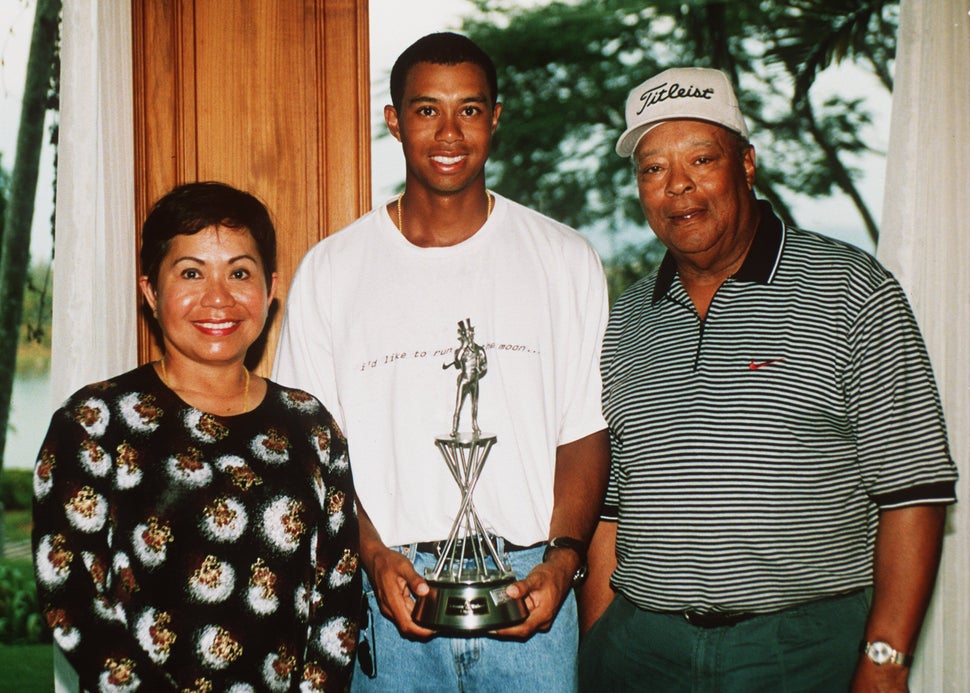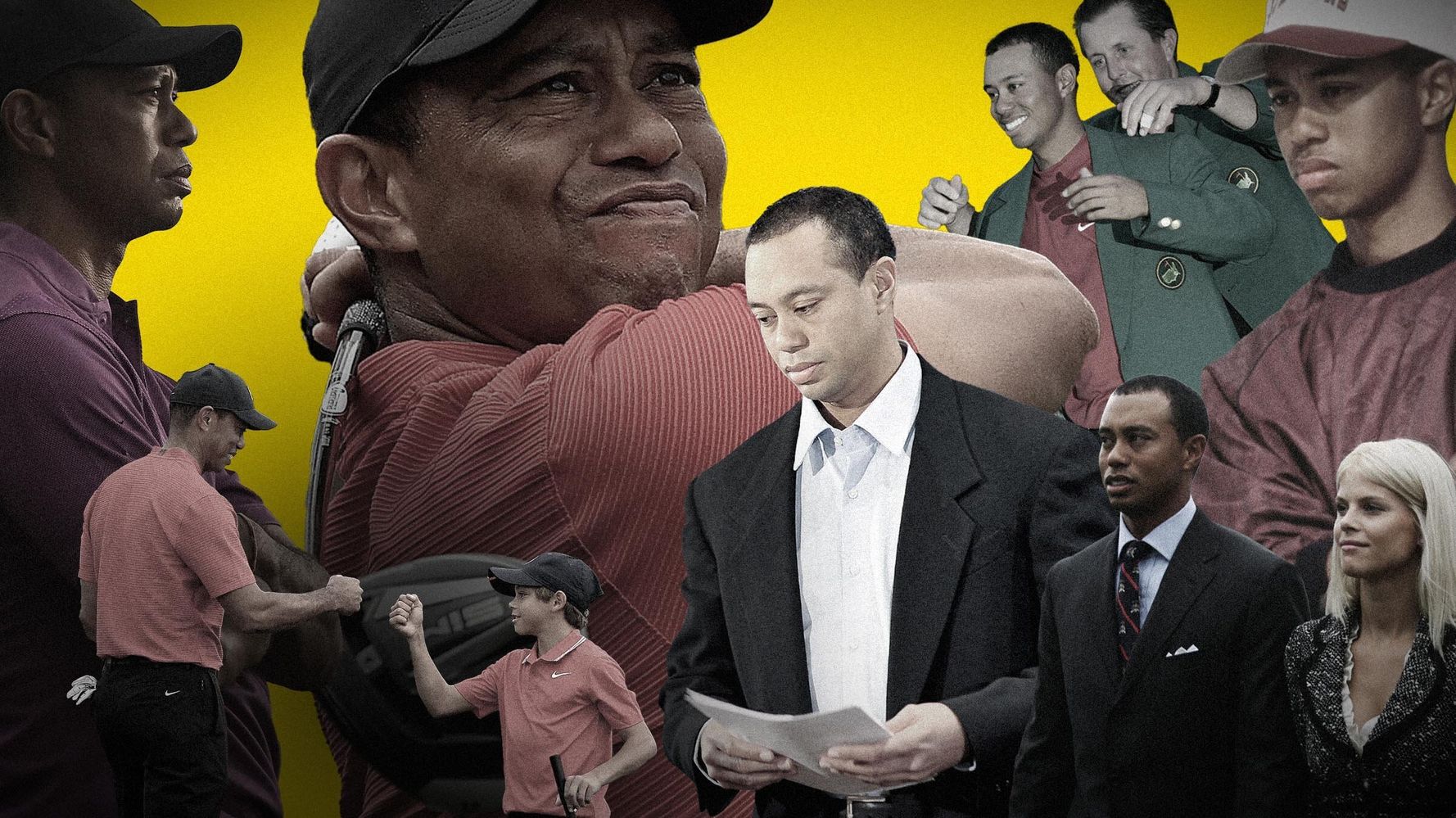On Thanksgiving night 2009, the legend of Tiger Woods imploded. He wasn’t just the Nike-sponsored pro golfer who broke racial barriers and major records in the game; he was also now a tabloid fixture.
That evening, Woods smashed his black Cadillac Escalade into a fire hydrant outside his Wyndemere, Florida, mansion following a reported dispute with his then-wife, Elin Nordegren. The previous day, the National Enquirer had released a story about Woods’ alleged mistress, nightclub hostess Rachel Uchitel, and his squeaky-clean reputation ultimately came into question.
From there, story after story leaked to the press about Woods’ multiple affairs. He spent months in hiding before reportedly checking into a sex addiction clinic and delivering a carefully constructed apology to the public. Nordegren and Woods, who have two children together, divorced shortly thereafter.
All of these events and more are documented in HBO Sports and Jigsaw Productions’ new two-part series “Tiger,” which airs on HBO and HBO Max on Jan. 10 and 17. The series tracks the athlete’s rise, historic downfall and triumphant return at the 2019 Masters Tournament. Using Jeff Benedict and Armen Keteyian’s best-selling book “Tiger Woods” as a guide, directors Matthew Heineman (Oscar nominee for “Cartel Land”) and Matthew Hamachek (Emmy nominee for “Amanda Knox”) detail everything from Woods’ intense relationship with his father Earl to his injuries, prescription drug use and subsequent 2017 DUI arrest.
Although Woods is not involved in the project, the docuseries features exclusive interviews with his close acquaintances, including Woods’ former caddie and friend Steve Williams, six-time major golf champion Sir Nick Faldo, biographer Pete McDaniel, and Uchitel, who breaks her silence on their life-altering relationship.
It’s an intimate portrait of a man who was bred for greatness, only to have the high expectations placed upon him lead to his collapse.
As two white men, Heineman and Hamachek faced some criticism for documenting Woods’ legacy. (Woods is multiracial and controversially deemed himself “Cablinasian” in 1997 on “The Oprah Winfrey Show” in reference to his Caucasian, Black, Indian and Asian heritage.) When news of “Tiger” hit last July, Indian documentary director and editor Geeta Gandbhir questioned why only one executive of color, producer Sam Pollard, was included in the project.
I want to make you aware of the asks from the Black and brown community – as you have a huge platform, and the whole community needs to grapple with the issue of systemic racism in our community. Why was there not a director reflective of the community on this project? If there were two of you, couldn’t ONE of you have been Black or Asian? Accountability and leadership are needed at this time – you are in a great position to be a positive example.
Following that comment, members of the “Tiger” crew ― including Pollard, Heineman and executive producer Alex Gibney ― acknowledged the lack of diversity on the film and promised to make necessary hiring changes with future projects.
Heineman told HuffPost, “There’s a lot of work that needs to be done across our industry, on every aspect, from funding to festivals to individuals like ourselves putting together teams to help create greater equity within both our documentary community and entertainment industry, in general.”
In this interview with HuffPost, Heineman and Hamachek discuss the conversation surrounding “Tiger,” why they wanted to tackle the golf icon’s story and what they learned while delving into his life and career.
When did you take interest in or decide to take on a documentary about Tiger Woods?
Hamachek: In 2018, Jeff Benedict and Armen Keteyian published their book “Tiger Woods,” which was, in many ways, the inspiration for our doc. Shortly after it was announced that Jigsaw Productions had licensed it, I reached out and said, “I’ve been wanting to deep-dive into this story for many years.”
Then we started to look for another director, and Matt and I have worked together many times on films in the past and he’s obviously one of the most talented documentary filmmakers out there, so I was really excited to have him come on. That led to sort of two or three months of research and deep-diving into everything that had ever sort of been written about him. And then after that, we said, “How are we going to be able to tell this?”
We reached out to Tiger and his camp, but they let us know that he had a previously existing relationship with another media company that prohibited him from participating in anything else. And so after that, it was, “Who were the people in Tiger’s life that knew him best?” Because a lot of what’s been written about Tiger over the years is this at sort of arm’s length recording of people who walked the golf courses with him and wrote about his golfing prowess.
Matt and I really wanted to get to the bottom of “Who is Tiger Woods and how did he get to this place?” We wanted to talk to the people that have been in the living room with Tiger and knew him best at all these pivotal moments in his career. So we set out to find those people.
It had to be tricky to get them to speak with you, even if some of them, like his former caddie Steve Williams, no longer have relationships with him. How did you go about building that trust?
Matthew Heineman: I think everyone was and is quite fiercely protective of Tiger, even if they’ve been cut from his life. One of the bigger sides of gaining people’s trust was to make sure that we were going to be fair and honest in telling the story. Again, even people that have been screwed over by Tiger wanted to make sure that this wasn’t just some head job on him. And so, among many other factors, that was, across the board, something that we had to do to gain the trust of our subjects ― to explain what our intentions were.
Hamachek: In a lot of ways, all of these [interview subjects] are so protective of Tiger to this day because they’ve seen people use Tiger to create this sort of character that they wanted him to be. And so, one of the things that we really faced in making this was to make sure that we find the people that knew him best and talk to them and listen and understand who these people saw him as.
Did you guys know, right off the bat, what you were trying to accomplish? Or was it more of the footage and the interviews you were getting that made the story arc clear to you?
Heineman: This is the first talking head film that I’ve ever done, and I think the process of discovery is the most exciting part about making a film. We don’t go into a film with a sort of script or a preconceived notion of what we want. We really let our subjects dictate where the story is gonna go. There was no sort of master plan or agenda that we were trying to fulfill or essay that we were trying to write. We didn’t know how long the film would be, we didn’t know how many parts it would be. We just wanted to let the story dictate what the form should be.
I don’t know why Tiger would have to redeem himself to the public at all, and I certainly don’t know how winning a golf tournament would have anything to do with redemption in the first place.
Matthew Hamachek
Matt Hamachek, you’re an editor, so what made you want to switch gears and co-direct “Tiger”?
Hamachek: The thing that always fascinated me about Tiger is, in 2009 on Thanksgiving night, we all learned that, despite being one of the most famous people in the world, we knew almost next to nothing about him. And when you start to talk to all these people who knew him best, one of the things that they always point to is how, throughout his entire life, [he faced various pressures]. Whether it was his father, Earl, who, at the beginning of our film at this banquet in 1996, talks about how Tiger is going to unite the different races and tribes of humanity. Then Nike took that message and vision and sort of ran with it in the way that they presented Tiger to the world. And then after that, the rest of the media and the public at large projected all these expectations and identities onto Tiger. It was fascinating to learn about that.
And back to your original question, I was really fortunate to have somebody like Matt that I’ve worked with before, but also Sam Pollard, one of our executive producers, is a former editor who took the leap to become a director. To have Sam on board as somebody I could talk to and rely on to help me make this transition was really great.
You mention Sam Pollard, who was the only Black executive on the project. I wouldn’t be doing my job if I didn’t bring up the debate that sparked when this project was announced about the lack of diversity in the production team. What have you reflected on while addressing the importance of including different voices and perspectives in storytelling, especially when it involves a person of color?
Hamachek: Look, we take a great deal of care in how we tell these stories, but Matt and I both feel as if we could have done so much more to diversify the team than we did. And it’s something we’re certainly going to be focusing on as we move forward. But again, I feel really fortunate that we had Sam on because he really helped me make the transition [from editor to director] but also gave us a much-needed perspective.
Matt Heineman, I know you released a statement on this, but the past few years have definitely brought up the idea of filmmakers working within their “bubbles” and choosing to collaborate with people they’ve worked with before. Did this conversation make you consider opening up your circle to get different perspectives in your stories?
Heineman: For sure. I’m happy that that conversation happened around our film this summer. There’s a lot of work that needs to be done across our industry, on every aspect, from funding to festivals to individuals like ourselves putting together teams to help create greater equity within both our documentary community and entertainment industry, in general. I truly hope that [the conversation around “Tiger”] can lead to, and I think it has in some ways led to, some really important conversations beyond our film.
Race is a through-line of the documentary. How did you both go about striking a chord in the right way when it comes to the subject and Tiger’s own approach to his ethnicity?
Hamachek: The process of making a documentary is really listening to your subjects and finding the right people who, in this case, knew Tiger well. And if you talk to Pete McDaniel, who was an Earl Woods biographer and a really close friend of the family, there’s no question that, from his perspective, race played a really crucial role in Tiger’s life. I think what Pete says is a lot of this goes back to the way the public interacts with Tiger. [Addressing] race was one of the many expectations that people put on him.

I grew up watching Tiger play, but I didn’t know much about his father’s influence on him and the pressure to play golf from a young age. I mean, he was 2 years old when he appeared on “The Mike Douglas Show.” It’s eye-opening to see the kind of pressures he was put under from the start, and then what being thrown into the very white world of golf had to add to it.
Heineman: I knew almost nothing about Tiger going into making this show. I knew, obviously, Earl was a huge, formative part of his life, but by no means did I know the extent to which that was the case. That outsized role that Earl played in his life and in shaping Tiger, obviously along with his mother, Tida, was really fascinating to unpack with all our relevant subjects that we filmed with.
Yeah, you have one of his teachers, his first girlfriend, members of the media ― you kind of hit on every part of his life. I’m sure that was a plan going in, to get a sense of Tiger at every stage?
Heineman: Yeah. On the flip side of that, I don’t think we felt an obligation to have this be the encyclopedia entry with every sort of period and comma. This is not a cradle to grave, or not a cradle to the golf cart, story. This is an attempt to really understand this man. And so we were very targeted in our approach to doing so.
Then, of course, you tackle the public’s obsession with celebrity, where we cheer them on, we build them up and then we kind of sit around and wait for them to fall. Was that interesting to examine? These “idols” are humans like everybody else and they’re going to make mistakes.
Hamachek: In a lot of ways, the first part of our film is about all of these identities being thrust onto Tiger and the second part is about Tiger trying to find a life that was his. The interesting thing is, in 2009, when he essentially revealed himself to be a human being and not what they had created him to be in their mind, all those people that built him up pounced on him and seemed to take this great sort of glee in his downfall. Then when he started to make his comeback in 2018, all the same people that were piling on during the downfall started to cheer him on and talk about how this was a story of redemption, which always confused me. I don’t know why Tiger would have to redeem himself to the public at all, and I certainly don’t know how winning a golf tournament would have anything to do with redemption in the first place.
What the people who knew him best point to in the period of 2018 onward ― and what we tried to put in the film ― was Tiger sort of found the joy in playing the game again and started interacting with the people he played with and interacting with fans. But there’s this interesting cycle of the media and the public where everybody’s sort of building him up and tearing him down and then jumping right back on the bandwagon of building him up again. I think that’s a fascinating part of the story.
You cover Tiger’s sex scandal that led to the collapse of his career. How did you go about approaching it in a fresh way, since it was heavily documented in the media at the time?
Heineman: There’s surely been enough of the scandal and by no means did we feel we wanted to dive into it. We had no interest in making any sort of a salacious exposé of the lurid details of his sex scandal. We wanted to try to understand, at least, what led him to that point? What was he seeking? What was he hoping for?
Obviously, one of the bigger interviews we got was Rachel Uchitel, and that interview could have gone in a bunch of different ways. But, for us, it was really an examination of “What was Tiger like at that time? Who was he? What was he like inside of that bedroom, not sexually, but what was going on in his mind? What was he hoping to connect with?” And as she says in the doc, he called [their meetups] “plugging in.” It was a way for him to talk in a way that he wasn’t able to talk in other aspects of his life. They texted all the time; they had a pretty deep relationship and that was honestly one of the more interesting things to me. For a lot of these women, it wasn’t just sex. They viewed it as a sort of deep emotional connection to this man. And it wasn’t just one person, there’s multiple people. So his ability to sort of compartmentalize and lead multiple lives, as Armen Keteyian says in the doc, was quite astounding during this period.
What are you hoping people take away from the film? I found it to be a sympathetic portrait of a man who was truly built to be one thing: the best golfer in the world, leading him to lack basic coping skills.
Hamachek: I think Tiger’s often been painted in really broad brushstrokes. A lot of people have tried to take away very simple answers for him. I hope that what we’ve been able to do in making this is show the complexity of who he is in the way that the people that knew him best saw him ― as a really complicated person who has had a lot of expectations and things projected onto him.
Heineman: In one sentence, we hope that this show is not just for Tiger Woods fans. We hope it appeals to the average person who is interested in docs, who’s interested in human nature, who’s interested in what is the price of greatness? You don’t need to care about golf or know anything about golf to be interested in this story. Hopefully.
“Tiger” airs Jan. 10 and Jan. 17 on HBO and HBO Max. This interview has been edited and condensed for clarity.
Calling all HuffPost superfans!
Sign up for membership to become a founding member and help shape HuffPost’s next chapter


